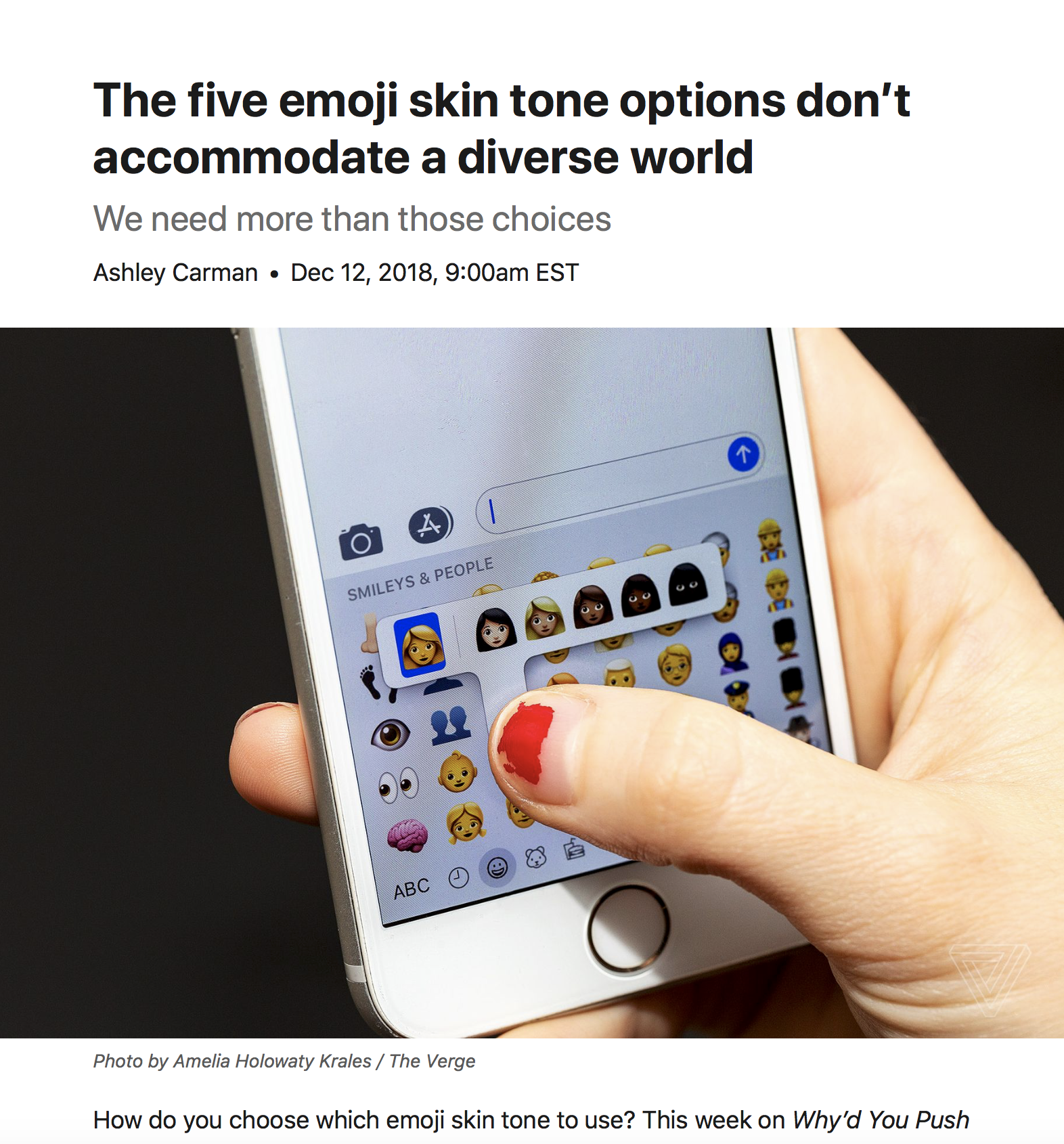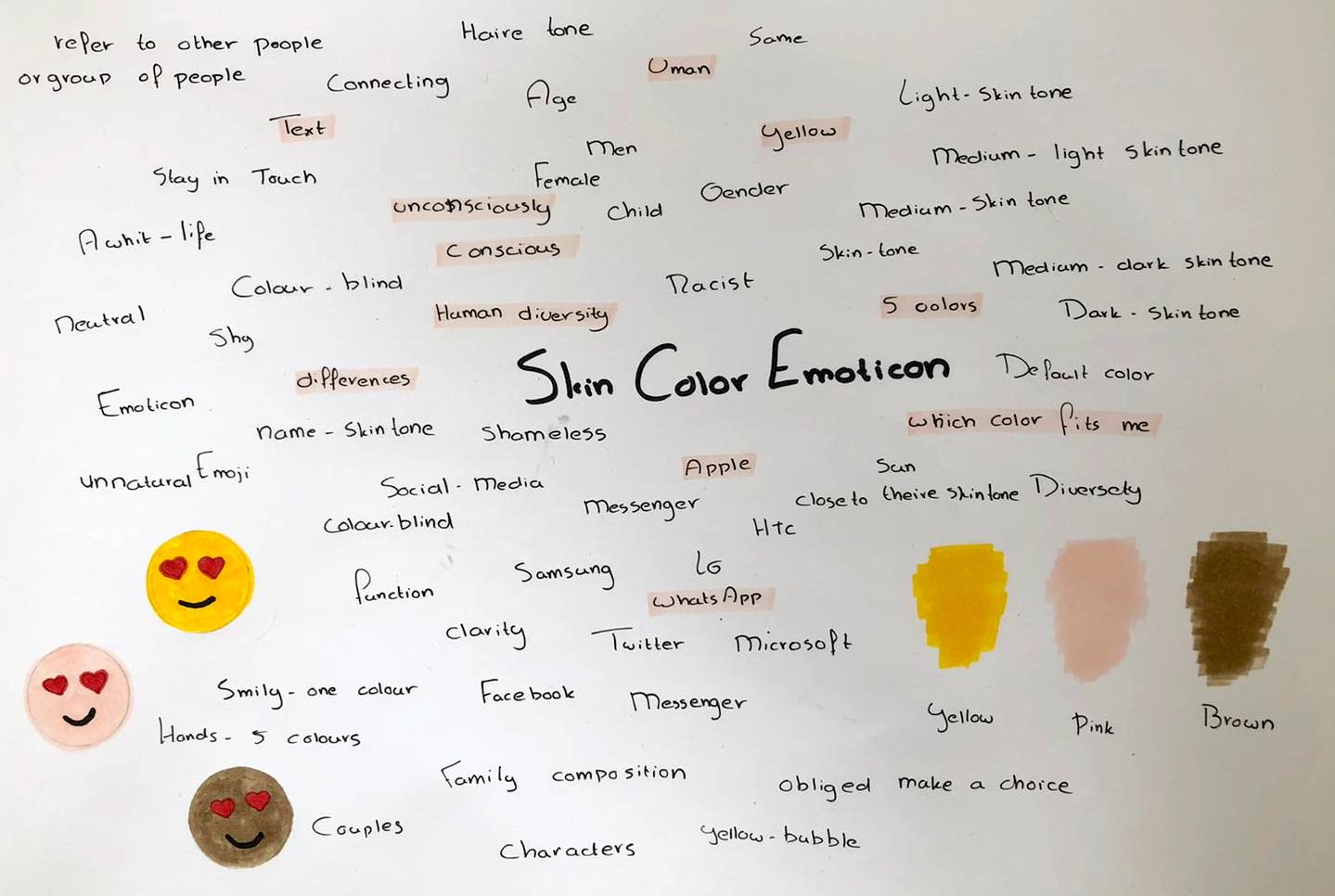Home
By Monique Hanse and Vera Nooijen
Body maps
Research
Mindmap
Midterm
Podcast
Class notes
Powerplay skin color
Neira, Juliana. “A closer look at the 230 new emojis arriving in 2019.” designboom.com. 6 feb. 2019. Web. 4 may 2020.
Notes:
-230 new emojis in 2019
- Since 2014 they continues to broaden its diversity and inclusivity while adding also a toch of silliness.
- They also made a guide dog, a hindu temple, symbols for the deaf and disabled.
- Two people holding hands with a total of 171 gender and skin and hair tone variations.
Notes:
- Graphic designer o’plérou grebet designed a series of ‘African emojis’ that reflect the culture of his home country.
- He created more than 370 designs.
- Grebet’s designs aren’t official emojis, because they have not been approved by the unicode consortium.
- He currently working on a submission to the body.
Notes:
- Apple has swapped out the official headshots of its executive mangement team for memojis.
- The PR stunt commemorates the reveal of 70 new emojis.
- First emoji was created in the late 90s by Japanese designer Shigetaka Kurita.
Notes:
- In 2015, the Unicode Consortium introduced five skin tone emoji that can be used in combination with emoji representing human figures and body parts.
- After characterizing the global distribution of skin tone emoji, a sentiment analysis is conducted. The correlation of skin tone emoji and sentiment may reflect demographic and economic realities but can also shed light on evolving attitudes towards skin color, race and ethnicity.
- Globally, more than 25 million tweets contained emoji that could take skin tone values, and these tweets contained approximately 19 million skin tone emoji.
Final map
Our first thoughts on a map what should it look like and what do we want to communicate with it?
- What do we want to achieve with our map?
- Can everyone express themselves in a color that suits them?
- Why 5 color's?
- Can we now discriminate even more easily?
- Do the skin color emoticons have more value than the yellow ones?
- How are the emoticons spread over the years?
- Why do we use emoticons?
- Emoticons are just masks
Plaats - Situatie - realisatie - ontdekking
- What do we feel
- How can we make it more personal?
- Our own identity
- what is the standard when we talk about skin color?
- A problematic topic that needs to be handled with care.

Notes:
- To make them look more human in terms of skin color, and five skin tones were added, and the idea was that this was going to help to represent human diversity.
- What we found is that overwhelmingly, people do pick a skin tone on an emoji that is very close to their own skin tone in real life.
- You’re going to find more light-skinned emoji on Twitter, and that’s simple because there are just more white people on Twitter.
- When you can control for different population sizes, you can actually look at their relative usages of these skin tone colors, and that’s where you see that white people essentially use them less often than people with darker skin tones.
- But in this new study that we’ve done, we looked at cases where people were using a skin tone color for their emoji that didn’t match their actual skin color.
- We found that often people will use them to refer to other people or to groups of people.
- what the data shows is that no, white people are essentially shameless, and they are using these very often but at a lesser rate than people with darker skins. I think that’s essentially because there isn’t that sense of pride that goes alongside being white, potentially, in the same way that, for minorities, taking that minority status and turning it into a badge of honor, that’s one way of dealing with being a minority and being proud of yourself and your background. Therefore, emoji can be a way of doing that.

Research maps
Article
Enquête
1997
2019
2020
2018
2015
2019
2015
Notes:
-Trying to pick the right emoji to convey exactly what you're feeling
-The problem is, the emoji you choose might be sending the wrong message
-If you believ that black skin is an inherent part of her message, she adds, then she needs to think harder about what it is about black skin that enhances her message.
-It wasn't until 2015 that we got another five skin tones to choose from. Now, I can virtually high-five my friends with a brown hand that looks more like mine.
2018
The same emoji when viewed on the Twitter website on a Windows PC or Mac shows Twitter's own emoji design, which shows a stifled laugh - the more common depiction of this emoji.
Miscommunication
2016
Notes:
- In 2015, the Unicode Consortium introduced five skin tone emoji that can be used in combination with emoji representing human figures and body parts.
- Every time I use an emoji, I have to make a choice: Do I use a colored racemoji, and draw attention to my ethnicity (even when it's not pertinent), or do I use a default emoji, which may misrepresent me altogether.
-This seems to be the crux of the matter. White people don’t have to use racemoji or risk denying their identity
-So it becomes a self-reinforcing cycle. When white people opt out of racemoji in favor of the “default” yellow, those symbols become even more closely associated with whiteness—and the notion that white is the only raceless color.
2020
2018
2018
Notes:
-For the past decade, it has set a similar standard for the emoji keyboard, so that nothing gets garbled in transit from one device to the other.
- Emojis offer a creative and universal form of expression that transcends language. They can even help bridge cultural and social divides as people develop vernaculars that are uniquely their own, yet accessible to all.
- Anyone can propose new emojis to the consortium.
Sketches
Inspiration
Final map sketch
The proces of making the final map with in Illustrator. We made 13 different images and put them al together in our final video.